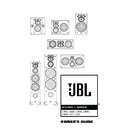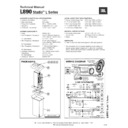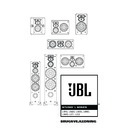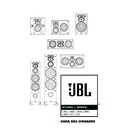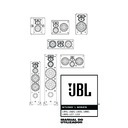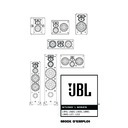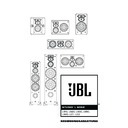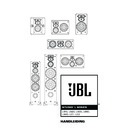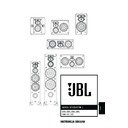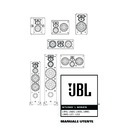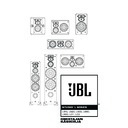JBL L890 (serv.man11) User Manual / Operation Manual ▷ View online
3
English
MODELS: LC1, LC2
The LC1 and LC2 center
channel loudspeakers are
designed to complement all of
the Studio L Series loud-
speakers. Either speaker is
ideal for re-creating the
cinematic experience in your
home.
channel loudspeakers are
designed to complement all of
the Studio L Series loud-
speakers. Either speaker is
ideal for re-creating the
cinematic experience in your
home.
MODEL: L820
The L820 loudspeakers are
designed to be oriented
horizontally, as shown in the
illustrations below. Although
designed to be oriented
horizontally, as shown in the
illustrations below. Although
these loudspeakers are
designed as a mirrored pair,
the decision as to which one
is left or right will depend on
designed as a mirrored pair,
the decision as to which one
is left or right will depend on
the amount of space left
between them.
between them.
A wider stereo image is
presented with the tweeter/
midrange array outboard, and
a tighter image is presented
with the array inboard.
presented with the tweeter/
midrange array outboard, and
a tighter image is presented
with the array inboard.
This placement provides a
wide spread in sound,
supplemented by the center
channel speaker.
wide spread in sound,
supplemented by the center
channel speaker.
0-0,6m
(0-2ft)
(0-2ft)
For stereo-only applications:
For home theater applications:
Less than 1,8m-2,4m
(6-8 feet)
Less than 1,8m-2,4m
(6-8 feet)
Speakers and electronics
have corresponding (+) and
(–) terminals. It is important to
connect both speakers
identically: (+) on the speaker
to (+) on the amplifier and (–)
on the speaker to (–) on the
amplifier. Wiring “out of
phase” results in thin sound,
weak bass and poor imaging.
have corresponding (+) and
(–) terminals. It is important to
connect both speakers
identically: (+) on the speaker
to (+) on the amplifier and (–)
on the speaker to (–) on the
amplifier. Wiring “out of
phase” results in thin sound,
weak bass and poor imaging.
To use the binding-post
speaker terminals, unscrew
the colored collar until the
pass-through hole in the
center post is visible. Insert
the bare end of the wire
through this hole; then screw
the collar down until the
connection is tight.
speaker terminals, unscrew
the colored collar until the
pass-through hole in the
center post is visible. Insert
the bare end of the wire
through this hole; then screw
the collar down until the
connection is tight.
BI-WIRING
The bi-wire connection
method requires one amplifier
and two sets of speaker wires.
By removing the shorting
bars, connections may be
made to the individual network
sections using four conductors,
one for each of the four
terminals.
method requires one amplifier
and two sets of speaker wires.
By removing the shorting
bars, connections may be
made to the individual network
sections using four conductors,
one for each of the four
terminals.
For single-wire connection,
leave the shorting bars in
place and connect only a
single set of speaker wires
(two conductors) to the two
upper terminals.
leave the shorting bars in
place and connect only a
single set of speaker wires
(two conductors) to the two
upper terminals.
SPEAKER CONNECTIONS
4
MODELS: L810,
L820, L830, LC1,
LC2
L820, L830, LC1,
LC2
The supplied self-adhesive
rubber feet may be attached to
the bottom corners of your
speakers to protect your
furniture.
rubber feet may be attached to
the bottom corners of your
speakers to protect your
furniture.
MODELS: L880,
L890
L890
These models feature four
rubber feet that enable them
to be placed on a smooth-
surfaced floor, such as tile or
hardwood. Four metal spikes
are supplied for use when the
speaker is to be placed on a
carpeted surface, to decouple
the speaker from the floor and
prevent unwanted damping.
To insert the spikes, gently lay
the speaker on its side (not its
rubber feet that enable them
to be placed on a smooth-
surfaced floor, such as tile or
hardwood. Four metal spikes
are supplied for use when the
speaker is to be placed on a
carpeted surface, to decouple
the speaker from the floor and
prevent unwanted damping.
To insert the spikes, gently lay
the speaker on its side (not its
front or back) on a soft,
nonabrasive surface. Each
spike screws into the threaded
insert in the center of each
rubber foot. Make sure all
four spikes are screwed in
completely for stability.
nonabrasive surface. Each
spike screws into the threaded
insert in the center of each
rubber foot. Make sure all
four spikes are screwed in
completely for stability.
NEVER drag the speaker to
move it, as this will damage
the spikes, the feet and/or the
wood cabinet itself. Always
lift the speaker and carry it to
its new location.
move it, as this will damage
the spikes, the feet and/or the
wood cabinet itself. Always
lift the speaker and carry it to
its new location.
SPEAKER SETUP
– +
– +
– +
Amplifier
High Frequency
Low Frequency
Bi-Wire Connections
– +
– +
Receiver’s Speaker Outputs
– +
– +
– +
LEFT
LEFT
RIGHT
RIGHT
– +
MODELS: L810,
L820, L830, L880,
L890
L820, L830, L880,
L890
MODELS: LC1,
LC2
LC2
Receiver’s Speaker Outputs
Place pads here
Right
Left
Right
Left
Center
Center
Amplifier
High Frequency
Place pads here
English
(Models L810, L820,
LC2)
LC2)
Important Safety Notes
• Proper selection of mounting
hardware and installation of
the wall brackets are the
responsibility of the customer.
hardware and installation of
the wall brackets are the
responsibility of the customer.
• This product is not intended
for ceiling mounting.
for ceiling mounting.
Two Number 8 round-head or
pan-head screws should be
used for each loudspeaker.
The screw head should be
between 5/16 inch (8mm) and
1/4 inch (6.3mm) in diameter,
and the screw should be at
least 2 inches (50mm) in
length.
pan-head screws should be
used for each loudspeaker.
The screw head should be
between 5/16 inch (8mm) and
1/4 inch (6.3mm) in diameter,
and the screw should be at
least 2 inches (50mm) in
length.
When installing screws in any
wall, it is always preferable to
screw them into a wall stud. If
none is available, it is
important to always use
properly selected wall
anchors.
wall, it is always preferable to
screw them into a wall stud. If
none is available, it is
important to always use
properly selected wall
anchors.
Attach two of the four self-
adhesive rubber pads that
came with the loudspeaker to
the back of the enclosure in
the two bottom corners so
that the cabinet is spaced
evenly from the wall. Select a
suitable mounting location on
a wall. (The ceiling is not a
suitable mounting location.)
adhesive rubber pads that
came with the loudspeaker to
the back of the enclosure in
the two bottom corners so
that the cabinet is spaced
evenly from the wall. Select a
suitable mounting location on
a wall. (The ceiling is not a
suitable mounting location.)
Drill two pilot holes,
appropriately sized for the
specific self-tapping screw or
wall anchor that you will be
using. A template is included
appropriately sized for the
specific self-tapping screw or
wall anchor that you will be
using. A template is included
with your loudspeaker that
indicates the proper locations
for the pilot holes. In the event
that the template is missing,
refer to this chart:
indicates the proper locations
for the pilot holes. In the event
that the template is missing,
refer to this chart:
Model
Distance Between
Pilot Holes
Pilot Holes
L810
152mm (6")
L820
216mm (8-1/2")
LC2
368mm (14-1/2")
See Figure 1. The holes
should be 57mm below where
you want the top of the
enclosure to be positioned.
Use a carpenter’s level to
ensure that the holes are
even and that the speaker will
mount on the level.
should be 57mm below where
you want the top of the
enclosure to be positioned.
Use a carpenter’s level to
ensure that the holes are
even and that the speaker will
mount on the level.
Install the two screws into
either a wooden wall stud or
anchor, and tighten them until
the back of each screw head
is about 1/8" (3mm) from the
wall. See Figure 2.
either a wooden wall stud or
anchor, and tighten them until
the back of each screw head
is about 1/8" (3mm) from the
wall. See Figure 2.
Models L810 and L820 may
also be corner-mounted using
the keyholes located on the
bezeled corners. For corner
mounting, fold the mounting
template in half, place the fold
in the corner at the desired
height, and use the outer
holes. In case the template is
missing, for corner mounting
drill each pilot hole 7-3/4"
(197mm) from the corner for
model L810, or 9-11/16"
(246mm) from the corner for
model L820. However, if your
corner is not precisely 90
also be corner-mounted using
the keyholes located on the
bezeled corners. For corner
mounting, fold the mounting
template in half, place the fold
in the corner at the desired
height, and use the outer
holes. In case the template is
missing, for corner mounting
drill each pilot hole 7-3/4"
(197mm) from the corner for
model L810, or 9-11/16"
(246mm) from the corner for
model L820. However, if your
corner is not precisely 90
degrees, these measurements
may not work. In that case, it
is recommended that you
contact a professional custom
installer, who can determine
the correct locations for the
pilot holes. Install the
loudspeaker by slowly moving
the cabinet toward the
screws so that the screw
heads clear the larger
circular portion of the two
keyholes. Once both screw
heads have entered the
keyholes, the loudspeaker
should gently be lowered onto
the screw shafts. Check that
the loudspeaker is firmly
locked onto the screws by
gently pulling the speaker
down and forward.
may not work. In that case, it
is recommended that you
contact a professional custom
installer, who can determine
the correct locations for the
pilot holes. Install the
loudspeaker by slowly moving
the cabinet toward the
screws so that the screw
heads clear the larger
circular portion of the two
keyholes. Once both screw
heads have entered the
keyholes, the loudspeaker
should gently be lowered onto
the screw shafts. Check that
the loudspeaker is firmly
locked onto the screws by
gently pulling the speaker
down and forward.
WALL-MOUNTING
See Chart
3mm
(1/8")
(1/8")
5
CAUTION: Floorstanding
(tower) loudspeakers have a
high center of gravity and may
become unstable and tip over
during earthquakes, or if
rocked, tipped or improperly
(tower) loudspeakers have a
high center of gravity and may
become unstable and tip over
during earthquakes, or if
rocked, tipped or improperly
positioned. If this is a concern,
these speakers should be
anchored to the wall behind
them, using the same
procedures and hardware
customary for anchoring
these speakers should be
anchored to the wall behind
them, using the same
procedures and hardware
customary for anchoring
bookcases and wall units. The
customer is responsible for
proper installation and proper
selection of hardware.
customer is responsible for
proper installation and proper
selection of hardware.
Fig. 1
Fig. 2
See Chart
6
SPECIFICATIONS
L810
L820
L830
L880
Description
3-Way, 5-1/4" Bookshelf/
4-Way, 6" High-
3-Way, 6" Bookshelf
4-Way, Dual 6"
Wall-Mount Satellite
Performance,
Floorstanding
Mirror-Image,
Wall-Mount Satellite
Wall-Mount Satellite
Maximum
150W
150W
150W
200W
Recommended
Amplifier Power
Amplifier Power
Power Handling
75W/300W
75W/300W
75W/300W
100W/400W
(Continuous/Peak)
Nominal Impedance
8 Ohms
8 Ohms
8 Ohms
8 Ohms
Sensitivity (2.83V/1m)
88dB
90dB
90dB
91dB
Frequency
60Hz – 40kHz
55Hz – 40kHz
48Hz – 40kHz
30Hz – 40kHz
Response (±3dB)
Crossover
3500Hz, 20kHz
600Hz, 3500Hz, 20kHz
2500Hz, 20kHz
700Hz, 5000Hz, 20kHz
Frequencies
Ultrahigh-Frequency
19mm (3/4") Mylar
®
Dome
19mm (3/4") Mylar
®
Dome
19mm (3/4") Mylar
®
Dome
19mm (3/4") Mylar
®
Dome
Transducer
With Cast-Aluminum Chassis
With Cast-Aluminum Chassis With Cast-Aluminum Chassis With Cast-Aluminum Chassis
High-Frequency
1" Pure-Titanium Dome
1" Pure-Titanium Dome
1" Pure-Titanium Dome
1" Pure-Titanium Dome
Transducer
With Cast-Aluminum
With Cast-Aluminum
With Cast-Aluminum
With Cast-Aluminum
Chassis in JBL
Chassis in JBL
Chassis in JBL
Chassis in JBL
EOS
™
Waveguide
EOS
™
Waveguide
EOS
™
Waveguide
EOS
™
Waveguide
Midrange Transducer
N/A
4" PolyPlas
™
Cone N/A
4"
PolyPlas
™
Cone
With Rubber Surround
With Rubber Surround
and Cast-Aluminum
and Cast-Aluminum
Chassis; HeatScape
™
Chassis; HeatScape
™
Motor Structure
Motor Structure
Low-Frequency
5-1/4" PolyPlas
™
Cone 6” PolyPlas
™
Cone 6"
PolyPlas
™
Cone
Dual 6" PolyPlas
™
Cones
Transducer(s)
With Rubber Surround
With Rubber Surround
With Rubber Surround
With Rubber Surrounds
and Cast-Aluminum
and Cast-Aluminum
and Cast-Aluminum
and Cast-Aluminum
Chassis; HeatScape
™
Chassis; HeatScape
™
Chassis; HeatScape
™
Chassis; HeatScape
™
Motor Structure;
Motor Structure;
Motor Structure;
Motor Structures;
Symmetrical Field
Symmetrical Field
Symmetrical Field
Symmetrical Field
Geometry
™
(SFG
™
); Geometry
™
(SFG
™
); Geometry
™
(SFG
™
);
Geometry
™
(SFG
™
);
Oversized Kapton
®
Oversized Kapton
®
Oversized Kapton
®
Oversized Kapton
®
Voice Coil; Magnetic
Voice Coil; Magnetic
Voice Coil; Magnetic
Voice Coils; Magnetic
Shorting Ring
Shorting Ring
Shorting Ring
Shorting Rings
Magnetic Shielding
Yes
Yes
Yes
Yes
Baffle
Low Diffraction,
Low Diffraction,
Low Diffraction,
Low Diffraction,
IsoPower
™
IsoPower
™
IsoPower
™
IsoPower
™
Enclosure
Bass-Reflex with
Sealed
Bass-Reflex with
Bass-Reflex with
Dual FreeFlow
™
FreeFlow
™
FreeFlow
™
Front-Firing Ports
Rear-Firing Port
Front-Firing Port
Network
Straight-Line Signal
Straight-Line Signal
Straight-Line Signal
Straight-Line Signal
Path
™
(SSP)
Path
™
(SSP)
Path
™
(SSP)
Path
™
(SSP)
Terminals
Gold-Plated 5-Way
Gold-Plated 5-Way
Gold-Plated 5-Way
Gold-Plated 5-Way
Binding Posts,
Binding Posts,
Binding Posts,
Binding Posts,
Bi-Wirable
Bi-Wirable
Bi-Wirable
Bi-Wirable
Dimensions (HxWxD)
362mm x 311mm x 127mm
311mm x 391mm x 127mm
385mm x 222mm x 320mm
990mm x 222mm x 370mm
(14-1/4" x 12-1/4" x 5")
(12-1/4" x 15-1/2" x 5")
(15-1/4" x 8-3/4" x 12-3/4")
(39" x 8-3/4" x 14-3/4")
Weight per Speaker
14 lb (6.4kg)
19 lb (8.6kg)
22 lb (10kg)
54 lb (24.4kg)
Display

